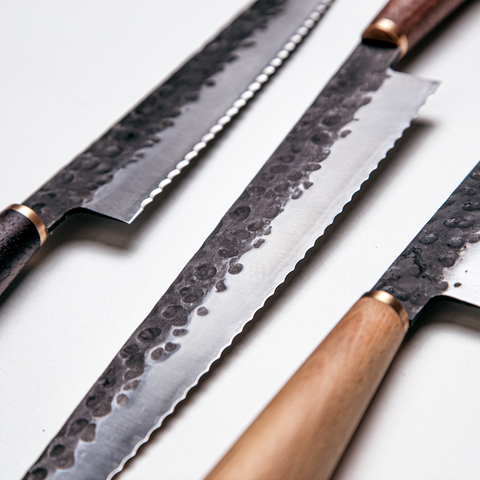Bread knives can come in all shapes and sizes, but they are unified by their purpose of - yep, you guessed it - cutting bread.
If you've ever tried cutting bread with a typical kitchen chef knife, you'll know the sheer impossibility of the task.
Not having the proper tool for the job can leave your bread slices in pieces and your loaf looking ravaged. A bread knife will not only make slicing quicker and easier, but it will also be more exact, allowing you to cut fine slices just as readily as you can carve out portions. Every home chef needs a bread knife in their home. Read on to find out why, as well as how to spot a good one.
WHAT IS A BREAD KNIFE?
The key differentiator between standard chef knives and bread knives is the teeth that can be found on a bread knife. All bread knives use serrated blades. These sharp teeth run along the edge of the knife's blade, and allow it to gain traction and pierce the surface of the bread you're trying to cut.
Essentially, they allow the knife to be used in a sawing motion which means it can cut through items with a hard or crusty exterior without damaging what may be a softer interior.
Non-serrated blades are a hazard when it comes to cutting bread, as the blades can easily slip off the hard exterior.
Most bread knives will tend to be quite lengthy so you can cut across the width of a large loaf of bread. Others though can have shorter blades and handle with their size being best suited to cutting something the size of a bagel.

HOW TO CHOOSE A BREAD KNIFE
If you’re cutting bread very regularly then the importance of getting a good bread knife can’t be understated.
Although bread knives share a lot of similar blade characteristics, the small differences between each blade can hugely alter the quality of the knife and thus the quality of the cut.
Plenty of this falls into how the blade is serrated. Some knives will have plenty of teeth, whereas others will have fewer teeth separated by larger gullets. The sharpness of the teeth will also vary from knife to knife.
Typically, you should go for a knife with fewer teeth as larger gullets will result in a smoother cut of bread. Sharper teeth will require less pressure when cutting the bread to make the job easier, the only trade-off being that they produce more crumbs.
Finally, making sure the handle has a good shape and heft so that you can use it should always be a consideration when it comes to knives.
KATTO'S BREAD KNIFE
Made from the highest quality materials, our 10.5" bread knives are fiercely serrated allowing them to glide through even the toughest sourdough.
The 10.5-inch blade is made from Japanese AUS-10 steel, making it both ultra sharp and durable.
On top of this, the handle is also available in either walnut, beech or rosewood, meaning that you can be sure you will be cutting in style.